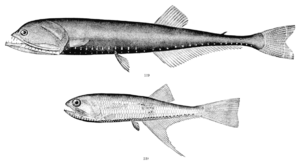Bristlemouths facts for kids
Quick facts for kids Bristlemouths |
|
|---|---|
 |
|
| Elongated bristlemouth, Gonostoma elongatum (top) and Bonapartia pedaliota (bottom) | |
| Scientific classification |
|
| Kingdom: | Animalia |
| Phylum: | Chordata |
| Class: | Actinopterygii |
| Order: | Stomiiformes |
| Suborder: | Gonostomatoidei |
| Family: | Gonostomatidae |
| Genera | |
|
Bonapartia |
|
Bristlemouths are a family of small, deep-sea fish. They are also known as lightfishes or anglemouths. These fish live in the Mesopelagic zone, which is a part of the ocean where sunlight barely reaches. There are 8 main types (called genera) and 32 different species of bristlemouths.
Even though there aren't many species, bristlemouths are super common! Scientists think there are hundreds of trillions, or even quadrillions, of them. The Cyclothone genus, with its 13 species, might be the most common type of vertebrate (animal with a backbone) on Earth.
Bristlemouths have been around for a long time. Their oldest fossils date back to the Miocene epoch. Modern bristlemouths were first found by William Beebe in the 1930s. They are mostly found in the Atlantic, Indian, and Pacific Oceans. One species, Cyclothone microdon, can even be found in cold Arctic waters.
These fish are usually 2 to 30 centimeters (about 1 to 12 inches) long. They have special organs called photophores that make green or red light. These lights are found along their heads and bodies. Their name "bristlemouth" comes from their unique, equally sized, bristle-like teeth. Bristlemouths are usually black, which helps them hide from predators in the dark deep sea. They mostly eat tiny ocean creatures like zooplankton and small crustaceans.
Contents
Amazing Bristlemouth Features
Bristlemouths have some cool features that help them survive in the deep ocean. Let's explore what makes them special.
Changing Gender
Bristlemouths are protandrous hermaphrodites. This means they start their lives as males. As they grow older, some of them can change and become females. Male bristlemouths are usually smaller than the females.
Big Jaws for Catching Food
Bristlemouths have very large jaws. These jaws help them catch prey that might even be bigger than themselves! For example, the lower jaw of one bristlemouth species is about 70% the length of its entire head. Scientists believe they swallow their food tail-first because their jaws aren't used for chewing.
Small Size and Appearance
Most bristlemouths are quite small, averaging about 7.5 centimeters (3 inches) long. They have long, thin bodies, small eyes, and short snouts. Their mouths and jaws are quite large. The position of their back fin (dorsal fin) lines up with their bottom fin (anal fin). The main differences between bristlemouth species are how dark their bodies are and the size of their light-producing organs. Otherwise, they look pretty similar.
Seeing in the Dark
Bristlemouths are mostly dark in color, but some can be see-through. They have a special organ called a pineal organ. This organ helps them sense slow changes in the dim light of the deep sea. This allows them to control their daily body clock and how they behave during different seasons.
Who Eats Bristlemouths?
Because bristlemouths are small, they can become food for bigger deep-sea predators. Fish like dragonfish and fangtooths often hunt them.
What Bristlemouths Eat
Bristlemouths mainly eat tiny ocean creatures called zooplankton and small crustaceans. About 92-98% of their diet is made up of crustaceans. Sometimes, they might also eat smaller fish if they get the chance. Bristlemouths that eat fish are usually larger, around 7 to 7.5 centimeters long. Their eating habits don't change much with the seasons.
Daily Food Hunt
Bristlemouths are diel vertical migrators. This means they move closer to the ocean surface at night to find more food. Out of the thirteen bristlemouth species, eight have been seen near the surface. This shows how important this daily up-and-down journey is for them. Their ability to make their own light also helps them catch food more easily.
How Bristlemouths Make Light
Bristlemouths are known for their bioluminescence, which means they can create their own light. They use this light for different reasons. Some bristlemouths use their light to find prey in the dark ocean. Others use it to avoid being eaten by predators.
The most common way bristlemouths use their light is to communicate with each other. It's like how people might dance or wear bright colors at a party to signal to others!
Images for kids





